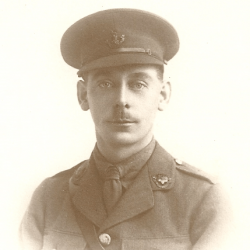Foreign Gallantry Awards
Foreign gallantry awards were sometimes given as a “consolation” if a British medal was not awarded. In some cases men were recommended for a Distinguished Conduct Medal (DCM) and it was downgraded to a Mentioned in Despatches (MiD) as it passed up the chain of command. Foreign awards were slightly different in that they generally passed down the chain of command and therefore there was more certainty over their award. The Military Medal was not established until March 1916 and although it was possible to make a retrospective award, it often didn’t happen and of course was not available in 1915.
Some foreign medals seem to have been made available to the British on a reciprocal basis, and were awarded to men who were chosen by British commanders as being particularly deserving, but who did not, for some reason, qualify for a British gallantry medal.
One particular feature of some of these foreign awards (which was in effect an MiD with related medal) was that they could be awarded posthumously. The French Croix de Guerre as an example. This made it especially useful for awarding to men who had lost their lives in gallant circumstances but who fell short of the requirements for the Victoria Cross, the only British gallantry medal that could be awarded posthumously. Confusingly, one hears sometimes of apparently posthumous awards of ‘lesser’ British gallantry medals, but on investigation these turn out to be confirmations after the recipient’s death of awards for which they had already been recommended.
Pte. WILLIAM SHEEKEY (2231) 1/9th Manchester Regiment was one such man who was awarded the Silver Medal, otherwise known as the Serbian “Milos Obilic” Silver Medal of Valour. In the London Gazette, the Serbian Silver Medal was listed under the heading of “Decorations and medals conferred by HIS MAJESTY THE KING OF SERBIA” and awarded for “gallantry and distinguished service in the field” which is the only citation available. [Gazetted Feb 15, 1917]
Silver Medal Background:
Milos Obilic was a medieval Serbian knight, considered an epitome of bravery and honesty, and who, legend has it, was captured by the Ottoman Turks at the end of the Battle of Kosovo in 1389. Presented as a prisoner of war to the Turkish Sultan Murad I, Obilic produced a hitherto-hidden dagger and stabbed and killed the Sultan, an act for which Obilic was beheaded. Ever since he personified the fearless, heroic Serbian warrior, ready to sacrifice own life in face of threatening defeat.
In the summer of 1913, the Kingdom of Serbia was overhauling its gold and silver Medals for Bravery, both in design and regulations, and opted to use the name and image of the great Serbian hero, Milos Obilic, in the design.
Award Criteria:
The medal was awarded for valour on the battlefield:
- The gold version of the medal could be awarded to officers for “valour tested in battle” and, in exceptional cases, to NCOs for “fearless bravery in battle”.
- The silver version could be awarded to NCOs and enlisted men for “bravery in battle”.
Description:
On one side of the medal is an ideal portrait of Milos Obilic in profile, wearing his armour and, near the edge, his name in Serbian Cyrillic, ‘MИЛОШ ОБИЛИЋ’.
On the other side of the medal, a cross with a pair of diagonal swords and, in the centre, the Serbian Cyrillic text, ‘ЗА ХРАБРОСТ’, which transliterates as ‘Za Hrabrost’, and translates to ‘For Bravery’.
Serbian recipients of the Milos Obilic Medal were exempt from taxes and it was the highest ranking Serbian medal at the time, which meant that, for a set of Serbian medals, it was worn in the leftmost position of the medal group, with the lower-ranking medals in their respective, regulated order or rank, being worn to the right of the Obilic medal.
References:
- ‘Serbian and Yugoslavian Orders and Decorations, 1859-1941’ by Pavel Car and Tomislav Muhić, 2009.
- The Europeana Collections Web Site.

